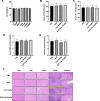Trigonelline hydrochloride attenuates silica-induced pulmonary fibrosis by orchestrating fibroblast to myofibroblast differentiation
- PMID: 38877465
- PMCID: PMC11179236
- DOI: 10.1186/s12931-024-02876-1
Trigonelline hydrochloride attenuates silica-induced pulmonary fibrosis by orchestrating fibroblast to myofibroblast differentiation
Abstract
Background: Silicosis represents a paramount occupational health hazard globally, with its incidence, morbidity, and mortality on an upward trajectory, posing substantial clinical dilemmas due to limited effective treatment options available. Trigonelline (Trig), a plant alkaloid extracted mainly from coffee and fenugreek, have diverse biological properties such as protecting dermal fibroblasts against ultraviolet radiation and has the potential to inhibit collagen synthesis. However, it's unclear whether Trig inhibits fibroblast activation to attenuate silicosis-induced pulmonary fibrosis is unclear.
Methods: To evaluate the therapeutic efficacy of Trig in the context of silicosis-related pulmonary fibrosis, a mouse model of silicosis was utilized. The investigation seeks to elucidated Trig's impact on the progression of silica-induced pulmonary fibrosis by evaluating protein expression, mRNA levels and employing Hematoxylin and Eosin (H&E), Masson's trichrome, and Sirius Red staining. Subsequently, we explored the mechanism underlying of its functions.
Results: In vivo experiment, Trig has been demonstrated the significant efficacy in mitigating SiO2-induced silicosis and BLM-induced pulmonary fibrosis, as evidenced by improved histochemical staining and reduced fibrotic marker expressions. Additionally, we showed that the differentiation of fibroblast to myofibroblast was imped in Trig + SiO2 group. In terms of mechanism, we obtained in vitro evidence that Trig inhibited fibroblast-to-myofibroblast differentiation by repressing TGF-β/Smad signaling according to the in vitro evidence. Notably, our finding indicated that Trig seemed to be safe in mice and fibroblasts.
Conclusion: In summary, Trig attenuated the severity of silicosis-related pulmonary fibrosis by alleviating the differentiation of myofibroblasts, indicating the development of novel therapeutic approaches for silicosis fibrosis.
Keywords: Fibroblast; Pulmonary fibrosis; Silicosis; Trigonelline.
© 2024. The Author(s).
Conflict of interest statement
The authors declare no competing interests.
Figures







Similar articles
-
Bicyclol attenuates pulmonary fibrosis with silicosis via both canonical and non-canonical TGF-β1 signaling pathways.J Transl Med. 2024 Jul 26;22(1):682. doi: 10.1186/s12967-024-05399-x. J Transl Med. 2024. PMID: 39060930 Free PMC article.
-
Mitochondrial folate pathway regulates myofibroblast differentiation and silica-induced pulmonary fibrosis.J Transl Med. 2023 Jun 6;21(1):365. doi: 10.1186/s12967-023-04241-0. J Transl Med. 2023. PMID: 37280614 Free PMC article.
-
Tetrandrine Alleviates Silica-induced Pulmonary Fibrosis Through PI3K/AKT Pathway: Network Pharmacology Investigation and Experimental Validation.Inflammation. 2024 Aug;47(4):1109-1126. doi: 10.1007/s10753-023-01964-6. Epub 2024 Jan 24. Inflammation. 2024. PMID: 38265677
-
The multifaceted role of macrophage mitophagy in SiO2-induced pulmonary fibrosis: A brief review.J Appl Toxicol. 2024 Dec;44(12):1854-1867. doi: 10.1002/jat.4612. Epub 2024 Apr 22. J Appl Toxicol. 2024. PMID: 38644760 Review.
-
Regulation of myofibroblast dedifferentiation in pulmonary fibrosis.Respir Res. 2024 Jul 18;25(1):284. doi: 10.1186/s12931-024-02898-9. Respir Res. 2024. PMID: 39026235 Free PMC article. Review.
Cited by
-
SIK2 Drives Pulmonary Fibrosis by Enhancing Fibroblast Glycolysis and Activation.Biomedicines. 2025 Aug 6;13(8):1919. doi: 10.3390/biomedicines13081919. Biomedicines. 2025. PMID: 40868174 Free PMC article.
-
Sex Differences in Urinary Metabolite Profiles between Survivors and Non-Survivors of Radiation-induced Lung Injury in the C57L/J Murine Model.Radiat Res. 2025 Jul 1;204(1):1-14. doi: 10.1667/RADE-25-00066.1. Radiat Res. 2025. PMID: 40383530
References
MeSH terms
Substances
Grants and funding
- 2022A15/Huazhong University of Science and Technology Fundamental Research Program, the Tongji Hospital (HUST) Foundation for Excellent Young Scientists, the Tongji Hospital (HUST) Foundation for key project
- SCZ202412/Hubei Provincial Medical Youth Elite Talent Program
- 2022020801020450/Wuhan Science and Technology Bureau "Dawn Light Plan Talent Project
- WJ2023Z010/Health Commission of Hubei Province scientific research project
- 82270104/National Natural Science Foundation of China
LinkOut - more resources
Full Text Sources
Medical

